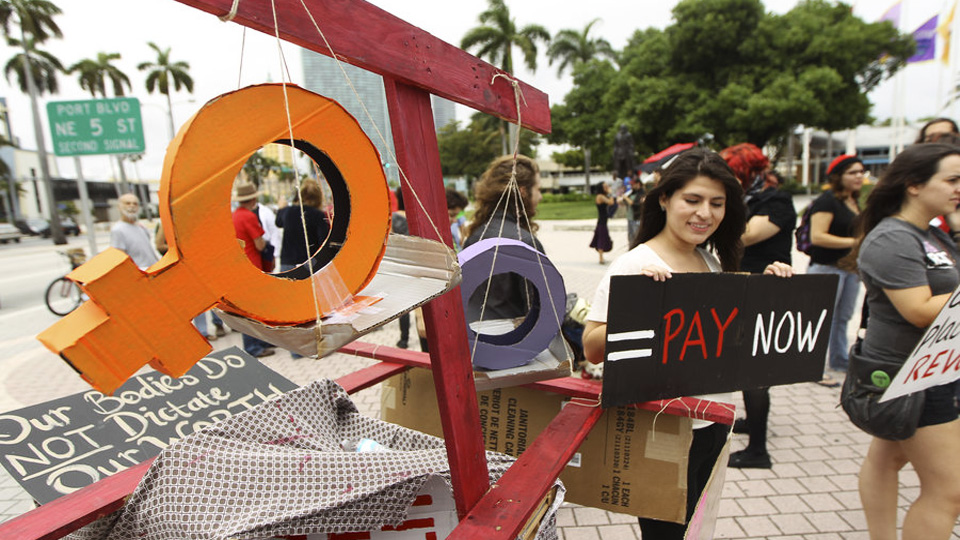
The gender wage gap, which has persisted for decades and continually leaves working women short-changed, has many causes that often don’t show up in pay stubs, a new Economic Policy Institute study says.
And commenters on a panel releasing EPI’s report – What Is the Gender Pay Gap And Is It Real? — delved into those causes, which range from the predominance of women in low-wage jobs, such as child care and home health care, to declining pay in other occupations as those jobs become more female, to the fact that even more education isn’t a solution.
The current gap shows the median pay for a female worker is 80 cents for every dollar a white man receives, in yearly wages, or 83 cents per dollar in weekly pay. The median is the point where half the workforce is above and half below.
Compared to white men, the standard, yearly pay medians for African-American women (66 cents) and Hispanic-American women (53 cents) are even worse.
The pay gap has become an issue in the 2016 presidential election campaign, with Democratic nominee Hillary Rodham Clinton vowing to push equal pay for equal work if she wins the Oval Office. The report, released Oct. 25, makes clear that a strong equal pay law will help, but that it’s not the total solution to the pay gap.
That’s because “women’s occupations” such as teachers and nurses are devalued, women are channeled in college into lower-paying majors, and millions of women are in the lowest-paying jobs in child care and elder care, the report and the panelists noted.
The panel also discussed various ways to close the gap. That gave one participant, Sarita Gupta, executive director of Jobs With Justice, the chance to state the obvious solution: Unionizing. Not only do unionized workers – men and women – out-earn their non-union colleagues, but the pay gap between male and female unionists is a dime per dollar.
“The number one way” to close the gap “would be to create a unionized workforce,” Gupta declared. With unions, “You are setting standards that say a job is paid a certain amount. It gives” woman workers “wages and bargaining power to set standards for equality.”
“The average woman worker loses more than $530,000 over the course of her lifetime because of the gender wage gap,” EPI reported. The average college-educated woman loses even more: $800,000.” Losses continue into retirement as lower wages for woman workers mean lower Social Security and pensions.
Ironically, highly paid women have even more of a gap than their lower-paid sisters. The highest paid women at the 95th percentile of earners – those in executive and professional ranks – have median hourly wages of $48, trailing men by $17, or 27 percent.
The lowest-paid women earn $8.61 hourly, eight percent less than $9.36 for the lowest-paid men. Panelists said that’s because the federal minimum wage, $7.25, puts a floor under those workers’ pay.
Education is touted as a way to close the gender pay gap, but EPI analyst Elise Gould says that’s not true. One reason is that even in higher education, women are channeled into majors – social sciences, human relations and the like – that lead to lower pay.
“Women can’t educate themselves out of the wage gap,” even though they now make up the majority of U.S. college graduates and approach the majority in some professions, Gould said. And their wages plateau when women are in their 40s and then start to decline, while men’s wages keep rising until retirement.
And, said Heidi Hartmann of the Institute for Women’s Policy Research, there is “occupational segregation” of women by industry and within the same industry. Both hurt working women, she added.
Hartmann used attorneys as an example. Proportionally, more woman attorneys become judges, who are among the lowest-paid professionals in the legal field, she said. Men, with the same qualifications and background, are promoted to corporate counsel jobs – the occupation’s highest-paid end.
“And secretaries working at non-profit organizations,” who are usually women, “make far less than secretaries working at GM,” Hartmann added.
Even when women break into so-called male occupations, such as science, engineering and mathematics, they still don’t fully catch up to their male counterparts, the panelists and the report note. But they’re still better off and their wage gap is less than if they stay in equivalent woman-dominated fields.
“We looked at middle-skill jobs” where workers earn $35,000 yearly in factories, transportation and information technology, Hartmann said, referring to IWPR’s own prior study of 250 sets of occupations. “Employers say ‘We can’t find people to fill them,’ and we say: ‘Look right under your nose, at the women.’” All three fields are male-dominated, IWPR found. Yet the needed skills are comparable to those woman workers use in other occupations.
Yet another factor in the wage gap is the major shift since the 1970s in the proportion of single-woman households with children, noted Letifa Lyles, director of the Labor Department’s Woman’s Bureau. With working women still saddled with primary child care duties, and even more so if they’re single parents, their pay is dragged down, she said.
“We don’t have any national policies that equalize pay for caregivers,” Lyles said. Such policies would free more women to work outside the home and for higher pay. “Other countries, like Canada, have much higher female labor force participation, because they have paid family leave and decently paid child care.”










